There was really only one organization that mobilized fan artists and writers
as a unit, and that was InterFan!
Fantafolio 3: 1980
Editor and publisher: Peppy White
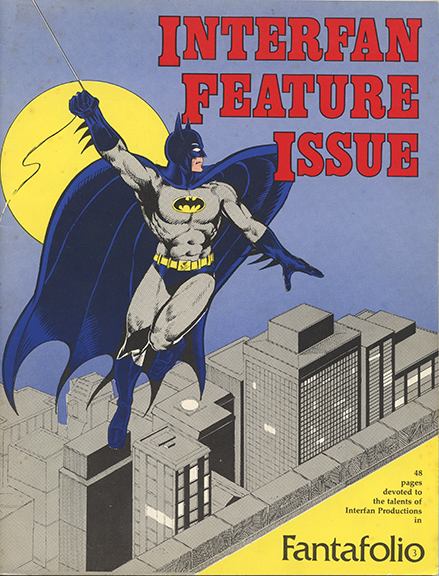
At only 20 years of age, Peppy White had already published three issues of his fanzine, Fantafolio. According to White, the fanzine had one main goal: to give a publishing venue to those artists that “…know just enough anatomy, design, and draftsmanship to draw, and yet need refining and sharpening.” White defined his fanzine as “…a collection of separate portfolios between two covers,” and this issue certainly exemplifies that.
This issue is a special one too, as it spotlights a very special and singular organization in fandom at that time, InterFan. InterFan was a group of artists and writers banded together to help one another improve and reach their various goals. You can read a lot of information on the group here. The main organizer, Steve Clement, unfortunately committed suicide years ago. Jim Bertges took over the helm after that. Jim told me via email that
I had a great time participating in InterFan, first as a writer, then actually running the whole show. It was our mission to get exposure for aspiring writers and artists, and to provide fanzines with illustrations and stories when they needed them. I was with the group from 1975 to 1985, then I passed the torch to Doc Boucher who keeps it alive to this very day.
When asked about his earliest exposure to fandom, Jim said,
I graduated from being a comic book reader to being a ‘fan’ in the summer of 1963 when my mom brought home a copy of Strange Tales Annual #2 in her shopping. That’s when I began collecting comics. I didn’t become aware of organized fandom until 1969 when I attended the first San Diego Comic Con with my friend Michael Reaves. My first fanzine would probably be The Comics Buyer’s Guide, but as we made frequent trips from San Bernardino to Hollywood and its vast array of collector’s shops, I was able to pick up ‘zines like Witzend, Promethean, Phantasmagoria, Trumpet, Realm, and a bunch of other assorted slick pro/fan ‘zines oriented toward both comics and science fiction.
He went on to say that running the organization was like having another full time job, with his mailbox constantly being full with requests to join, work to be scrutinized, and other assorted requests. Some of Bertges’s favorite fanzines include those you have seen here in Ink Stains, like David Heath Jr’s No Sex, Matt Bucher‘s Ultrazine, and Bill-Dale Marcinko’s Afta (soon to come). After being forced into early retirement from New Line Cinema (when Warner Brothers took over) in 2008, and 30 years in the movie business, Jim now builds science fiction and monster models on commission, just to keep his mind agile and his creative hand in action.
The organization helped many of the writers and artists who you know as professionals today reach their professional goals. Their numbers included Reuben Pharms, Don Secrease, Paul Daly, Harv Chin, Bud Perkins, Bill Neville, Willie Blyberg, Pete Iro, Carl Taylor, Doug Herring, Larry Houston, Mike Romsberg, Mark Lamport, Chris Ecker, Gary Ostanski, Rick Burchett, Mike Machlan, Ed Savage, Neil Riehle, Jerry Foley, John Beatty, Doug Hazlewood, Jerry Ordway, Dave Sim, Sam De La Rosa, and Karl Kesel, among others. You can find many memories from some of these individuals on the website. InterFan provided tons of material to various fanzines and magazines during it’s heyday, including The Comics Journal, The Comics Reader, The Comics Buyer’s Guide, and our hero, Fantafolio 3. So, let’s see our hero’s exploits, shall we?
The cover above is by John Beatty and Jerry Ordway. Those are two names you should know if you read comics, since both have gone on to exemplary careers. John Beatty was one of a few InterFan alumni that was nice enough to answer a few questions from me via Facebook. By the way, you can read a blog devoted to his early days here. John cites Peanuts and Dennis the Menace as early artistic influences, with his first fanzine experience being The Comics Buyer’s Guide (an experience he and I share). That seminal fanzine/adzine also connected Beatty with fellow artists Ordway, Willie Blyberg, and Tim Corrigan (who still publishes his own comics to this day). It was Corrigan’s fanzine, Crime Smashers, that would publish Beatty’s first fan work, though he had been able to sell his first work (a few cartoons) years earlier at age 15 to a local publisher.
As stated earlier, editor White wanted his fanzine to be a portfolio full of portfolios. Artists covered this issue include Mike Romesburg and Doug Herring. Herring was a mainstay of fandom in the mid seventies. His clean and crisp inking stood out amongst the beginners. One of InterFan’s practices was to run the work through an editor, to catch discrepancies and bad spots, with a goal to make the work as professional as possible. No doubt Herring benefited from some of the great inkers within the ranks, including people like Sam De La Rosa, Doug Hazlewood, Pete Botsis, and Pete Iro. Though Herring’s figures at the time could be a little stiff, you can see from the work below how advanced his inking skills were.
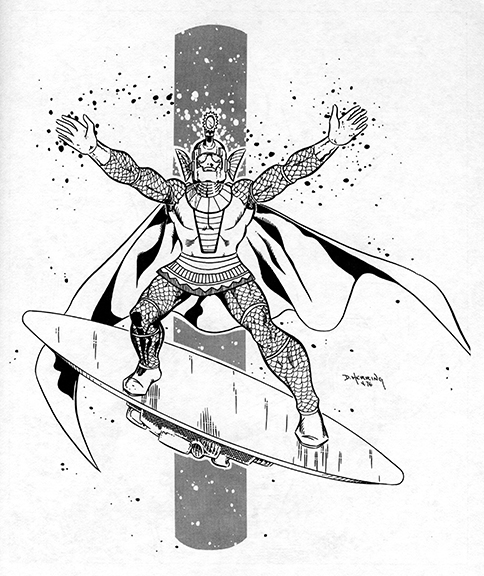
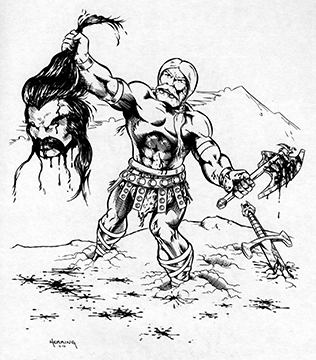
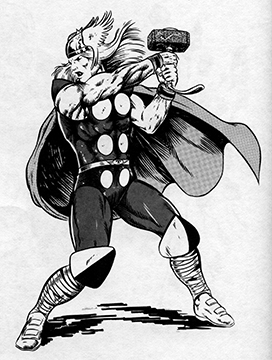
Other features in this fanzine that you can see in the free pdf download include God Creating a Super-Hero, Mike Romesburg’s portfolio, and a chapter of a book by author Gary Ostanski (illustrated by Larry Houston, who was also helpful via Facebook with his remembrances). Below you can see a few more full page (and full color) illustrations by Willie Blyberg/Doug Hazlewood, and Mike Machlan/Sam De La Rosa.

Doug Hazlewood was one of the best inkers in fandom at that time. You will see his work in many other fanzines profiled in Ink Stains. He was kind enough to answer some questions via email for this column. When asked about one of his first drawing experiences, Doug remembered “being singled out in elementary school for my drawing and won third place in a ‘Draw George Washington’ contest. When I looked at it later I realized I had forgotten to do his eyebrows. I was good at looking at photos in encyclopedias or books and doing my version of them. I also recall one teacher really liking my illustrations for Heidi (not very advanced). I remember them eating cheese sticking in my mind. All three of us also read comic books early on and would try drawing things from them (I was the youngest).” As for his first published work, he is “pretty sure it was just a little spot illustration ‘head shot’ in Marvel Tribune that I did in ballpoint pen. That was when I was advised to use India ink.” One of his favorite fanzines was Fantastic Fanzine from Gary Groth. He says that “I got one spot illo in there early on and then everything else was rejected. It certainly stood out and I even got my local buddy to buy a couple of issues.” He also enjoyed Radion by Tom Mason. As for InterFan, Doug thinks that “Sam De la Rosa got me involved. I would ink things he’d send me and Pete Iro also.” Doug says that “I didn’t think of it as ‘I’m doing this for Interfan’ as much. It did help get more things published than just contacting editors on my own. There were periods when fanzines just didn’t seem as good or ‘like they used to be’ and that was discouraging.” These days, Doug states, “I run into Sam at some shows and I reckon Ordway was in InterFan at some point. It was cool seeing some fan artists that you just knew were going to be pros (some of these pre-dated InterFan). Cockrum, Janson, and then Ordway, De la Rosa, Blyberg, Machlan, Bruce Patterson, and others.” Comics nowadays don’t have as much pull for Doug, who goes on to say, “I haven’t done anything for DC since the Reboot, but they are still reprinting some of my stuff thankfully. I don’t know if I have the urge to get back into it full-time again if the opportunity presented itself now that I have been away from it for over two years. I’ve been doing recreations and commissions, and finally got on Facebook recently. I feel more enthused about inking again, though I have also been selling some of my stuff I have collected over the years while I have the time to do it. I have a LOT of stuff.” Let’s see it, Doug!
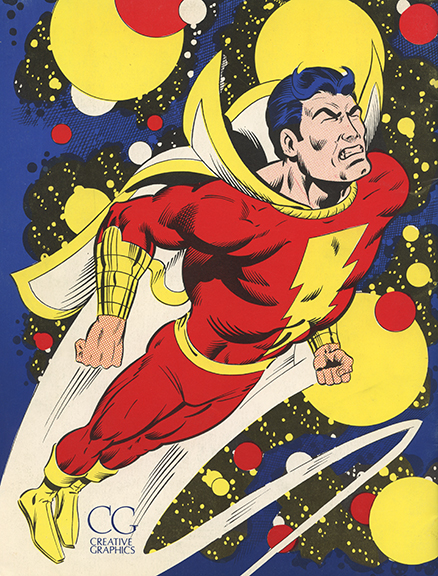
The coloring was credited to “Creative Graphics,” which I take to mean editor White, who was also an artist (and whose work you can also see in the pdf). Fantafolio 3 also features a few strips, including Always Comes Twilight by Art Cooper (with script assistance by Mil Sepic), sampled below.
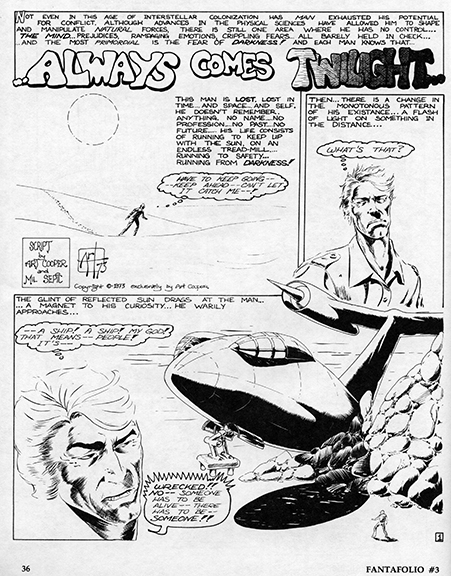
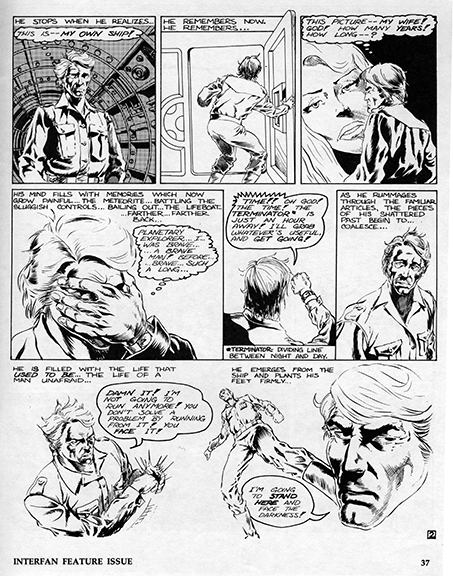
While Cooper’s art has a few surface similarities to Joe Kubert, the artist of the next story called The Little People of 92nd Street, Pete Botsis (with inks by a frequent collaborator, Pete Iro), might owe a little debt to Neal Adams, and possibly Mike Zeck, who had been a pro only a few years when this zine was published, mainly with Charlton Comics. Peter Botsis, another InterFan alumni who helped me with insight this column, ruminates on his experiences below.
I started drawing mainly because my older brother did. My first real comic book drawing/copying was Kirby’s Thor at about 8. The first zine I did anything for was by a neighborhood kid who I later became good friends with. The magazine was TCP, which stood for The Comic Press. My brother and I drew Conan on a chariot holding the reins. It was a classic Arnold Schwarzenegger rip off pose. As far as fandom, I really only got involved with InterFan, although I don’t remember when or even how. I did talk and meet with a few guys from InterFan, including Jerry Ordway, Mike Machlan, Pete Iro, and of course Steve Clement. Most of the stuff I liked was more pro based, such as Squa Tront or The Comic Reader. There were a few other fanzines, though their names escape me now. I do know Don Newton drew some awesome stuff for one of them. The main thing I recall about InterFan was Steve always sounding as if we were just about to hit the next level and good things were just around the corner. I heard he committed suicide, though don’t know many details as to why or how. The best thing about InterFan was connecting with other comic book artists. By collaborating with letterers and inkers that could add to your work it helped you see things with a more critical eye. I tried to keep up with a few guys but lost touch with them. Jerry Ordway was about the only one who I really talked to for any length of time. By and large they were all good guys and I hope they are all doing well. I have a website that has a couple of pieces that people can see here. But if you really wanted to see a lot of my work you’d have to go to my basement! It’s mostly pencil rejects for submissions to Marvel an DC with a few things for Amazing Stories or Dungeons and Dragons. That’s about it.
The two Petes had no qualms about using deep blacks, dark shadows, and tricky layouts. Iro was also already an accomplished letterer, as you can see from this story.
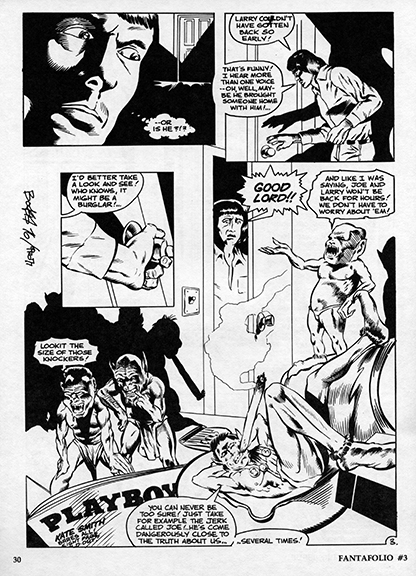
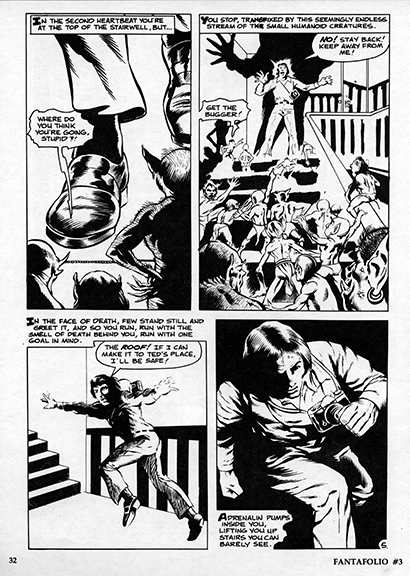
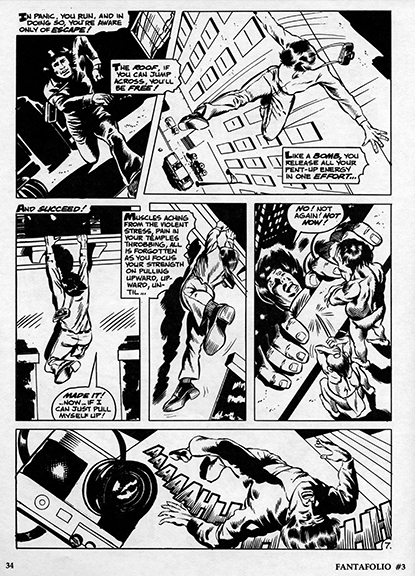
The last sequential story in this fanzine is written by Interfan editor Bertges, drawn by Rick Neville, and inked/lettered by Rick Burchette. Burchette would jump in the pro ranks with both feet, working for First, Pacific, Capital, AC, and later DC. He was also instrumental in getting Jim Lee into the comic field. Additionally, he has received the Eisner award…twice! See a sampling of the strip below.

Larry Houston is another InterFan alumni, and has gone into the world of animation. Fittingly, it was the animated TV show Astro Boy that got him onto art as a child. He went on to find more inspiration in the discarded and tattered comics in the baskets of his local barber shop. One of his first publication experiences in fandom was in the long running fanzine The Comic Reader. Professionally, his first experience was as an inker in All-Star Squadron for DC. Charlton published his own concept, The Vanguards. His animation work began with Marvel Productions, where he worked on Spider-Man and His Amazing Friends. Larry enthused that his time with InterFan was one of the most enjoyable times of his life, and “allowed the free, uninhibited expression of our creativity, and I think that helped me achieve some of my goals. Seeing small illos printed or thoughts published, it all adds up, it’s accumulative in the end.” Some of Larry’s proudest moments include animation for The X-Men: The Animated Series, The Fantastic Four second season, and the GI Joe movie intro. Be sure to check out Larry’s website here for more information.
There are a few more pieces of art you can see in the pdf, but one in particular I want to show you below. You can see that even the most amazing artists have to start somewhere. One of my favorite ‘realist’ artists ever in comics is David Mazzucchelli. His Rubber Blanket series was experimental both in printing and subject matter, and of course his runs on Daredevil and Batman were highly praised for the very reason I love his work. Below you can see one of his very early works, a pin up done in 1976 while in Interfan.
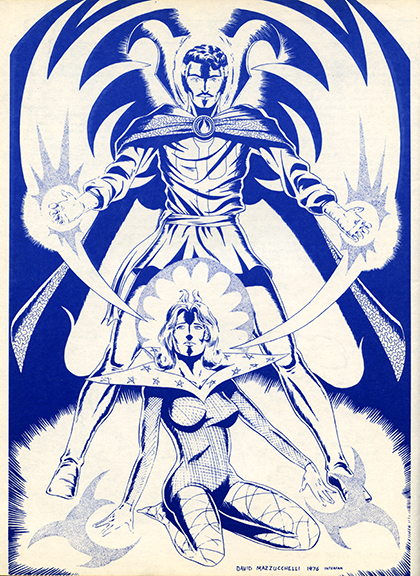
Another InterFan artist, though not in this issue, is Jerry Ordway. Another alumni that was gracious enough to answer some questions for me via email. I had to include him! You can see my questions followed by his well ordered answers.
Other artists you can see in the pdf here (it is big enough for two parts) include Chris Ecker, Dan Secrease, Ed Savage, Rich Schindler, Jim McPherson, and Mark Lamport. And please, go check out the Interfan page at the link near the beginning of the column, you will find a wealth of information and anecdotes from various members…you will most likely be incredibly surprised at the talent that sprung from this amazing organization.
Thanks for help this time go out to John Beatty, Jim Bertges, Larry Houston, Jerry Ordway, Peter Botsis, and Doug Hazlewood.
Tune in next month for who knows what…all I know is that it will be another cool fanzine!
Ken Meyer Jr.
kenmeyerjr@yahoo.com



I would always stare in wonder at Hazlewood’s work. He had such control over his line that the original art was breathtaking.
Jim Bertges…always a class act!
Great stuff…been waiting with baited breath for new Ink Spots- lol…well worth the wait, Ken!
thanks for the comments, guys, makes me think people are actually there!
One of the zines I worked on that utilized material from Interfan was Brad Young’s great little digest, “Unpublished.” Issues #1-3 were published in 1976, 1977 and 1978, respectively.
The five-page story you show above, “Incident at the End of the World,” was the lead story in “Unpublished” #1. There’s an Ordway “Messenger” illo in the issue as well, and a back cover by Doug Rice.
In the third issue, there’s a five-page, EC-style Interfan horror strip titled “Momma’s Boy,” along with a back cover by Ordway.
Great stuff!
Thanks a bunch, Russ!
Pingback: Kibbles ‘n’ Bits 4/10/14: Check out the SCHMUCK Kickstarter! — The Beat
Pingback: Kibbles ‘n’ Bits 4/10/14: Check out the SCHMUCK Kickstarter! | ComicBookRAW
Hi Ken, Thanks for this. ( It’s actually spelled Steve Clement, no “S” and David Mazzucchelli. Best to all the Inter-Fan guys…..Here’s a list of work by Steve Clement I just found
http://www.bailsprojects.com/bio.aspx?Name=CLEMENT%2C+STEVE
Pingback: Ink Stains 122: Fans-Zine 7 – ComicAttack.net
Pingback: Ink Stains 66: Woweekazowie 1 – ComicAttack.net
Pingback: Ink Stains 131: Marvel World 2 – ComicAttack.net